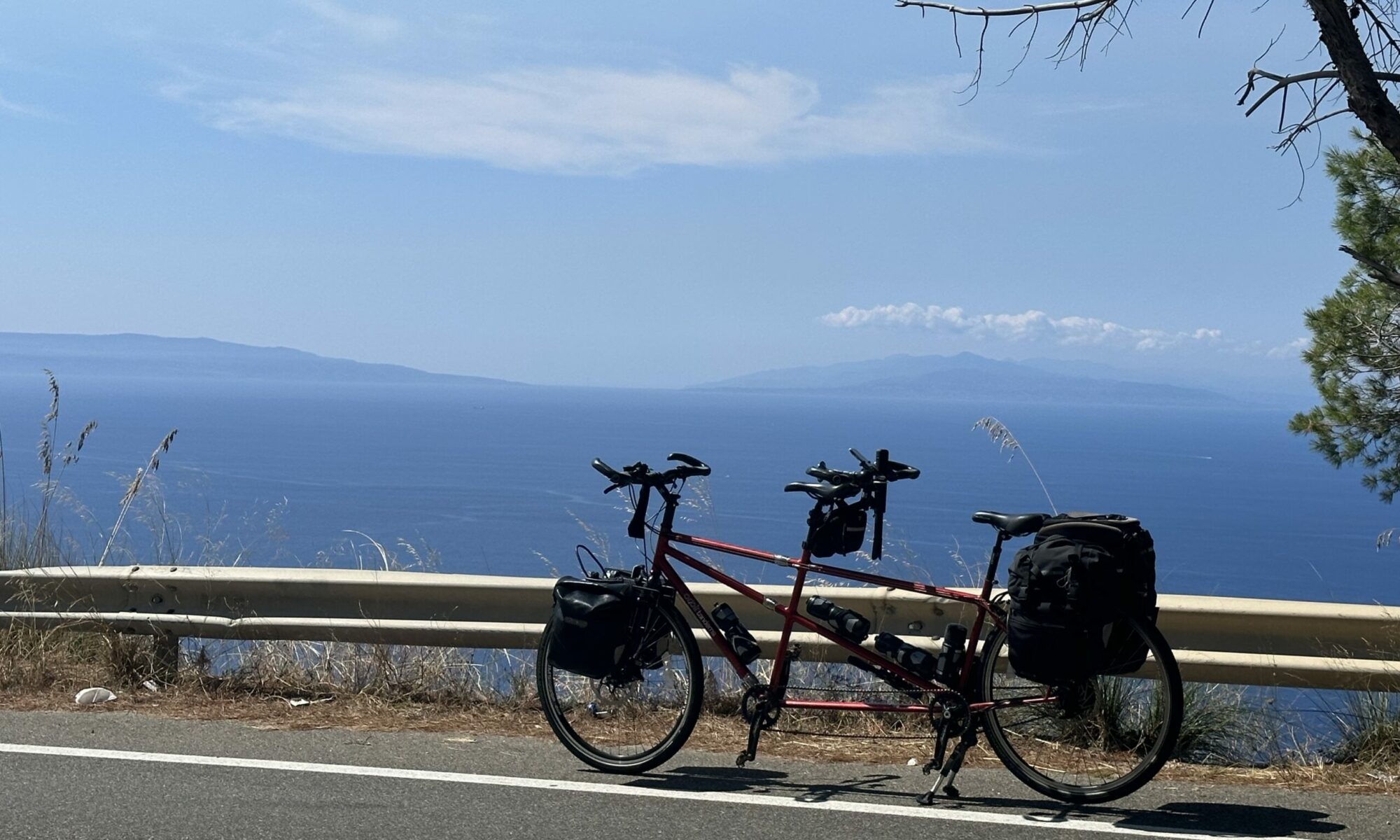Motorhome day forty-four: Rotorua to Waitomo
Bidding farewell to the geothermal regions of Taupō and Rotorua (and to the attendant whiff of sulphur) we drove west out of Ngongotaha. It had been a fascinating few days surrounded by the ever-present evidence of volcanic activity, but it was time to move on.
Our first stop today was at Blue Springs. This is a remarkable site, not least for the complete clarity of the spring water. Apparently this has been filtered through rocks for fifty to one hundred years, and the blue colouring is testament to its purity. Combine the pure water with a slow flowing current and abundant quantities of vivid green weed beneath the water surface, and you end up with yet another bewilderingly beautiful location.
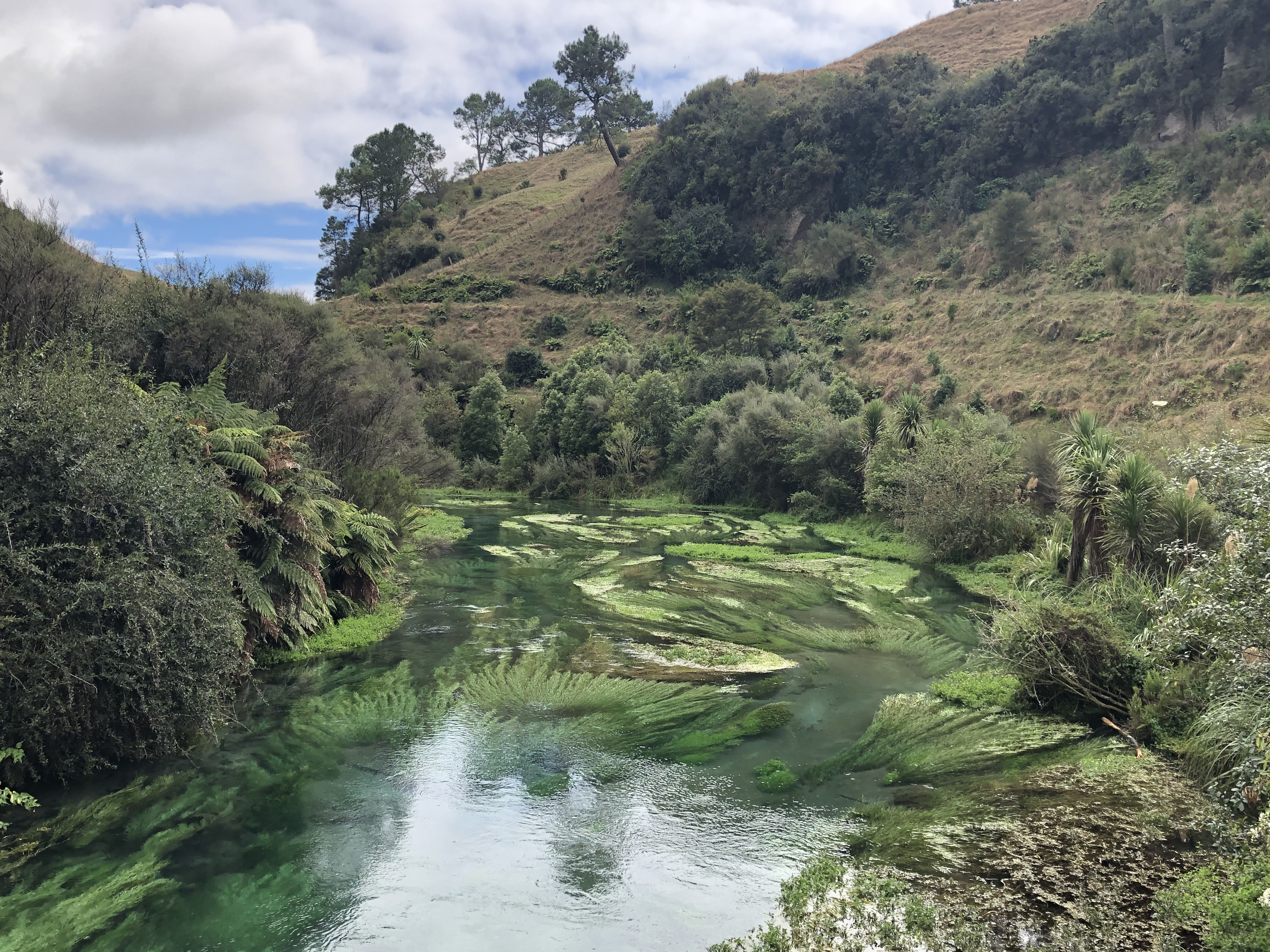
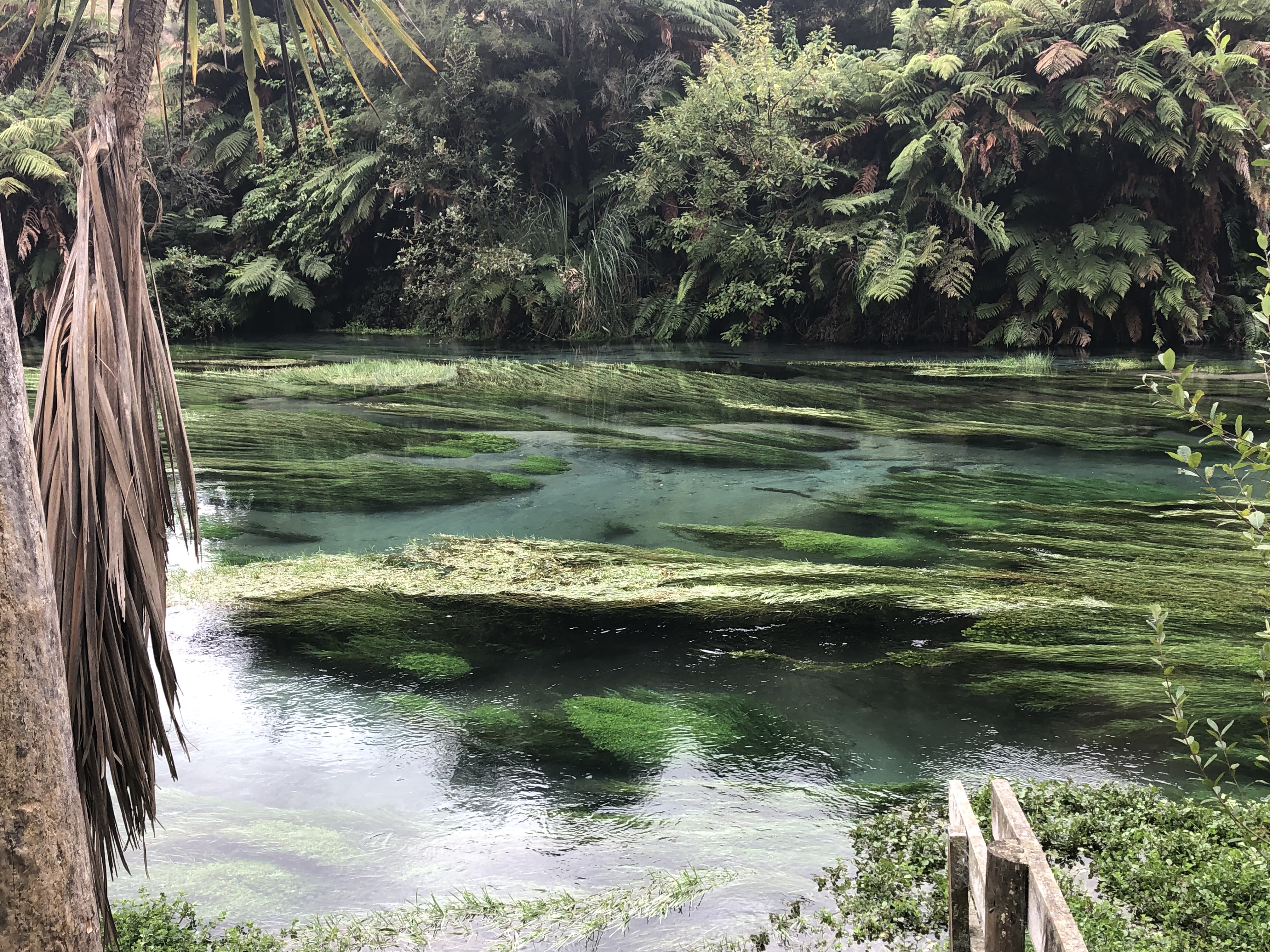
We’ve remarked, previously, on the clarity of the water here in New Zealand. On only three occasions have we encountered murky water – twice as a result of algae contamination, and once because the water was full of glacial rock flour, and vivid turquoise as a result. In every other circumstance it has been clean.
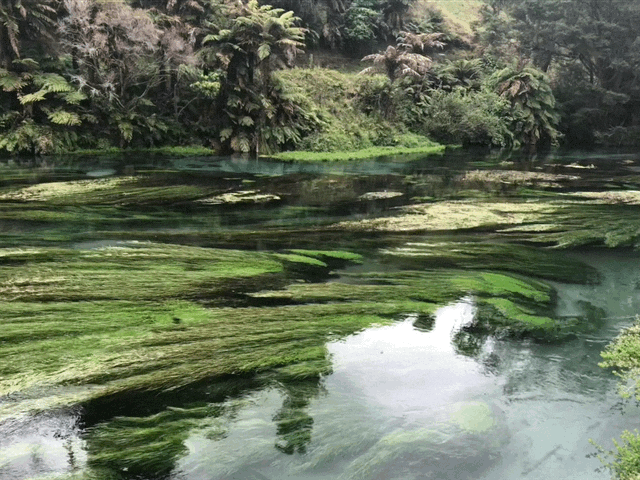
We wandered up a wooden walkway. Swimming was forbidden, understandably, but we looked at the water with a tinge of regret, it looked so tempting.
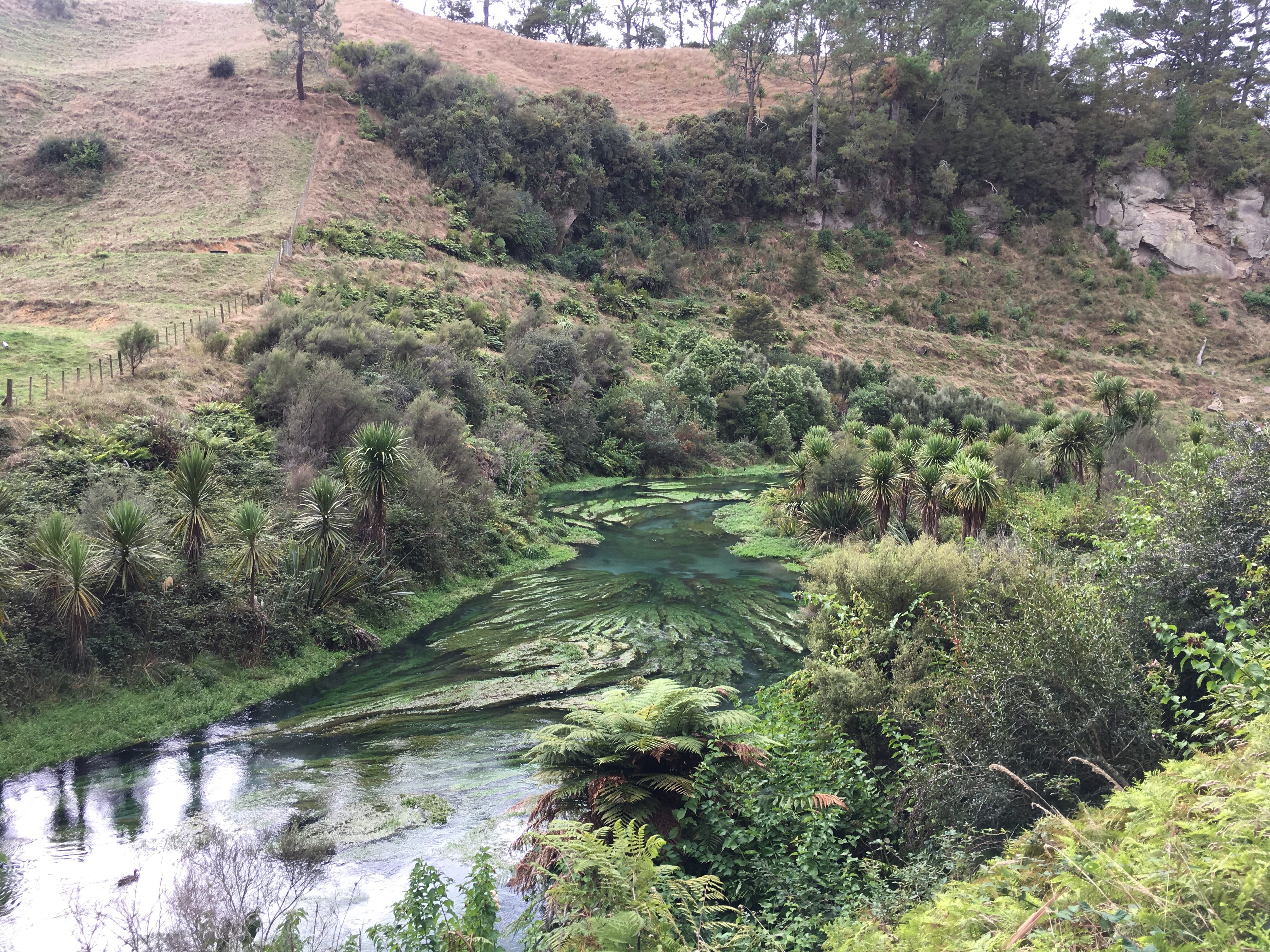
We moved on, on main roads to start with. After a while we arrived at Te Awamutu. Music enthusiasts might know this as the birthplace of the Finn brothers, Tim and Neil, who performed together in the group Split Enz, and later in Crowded House.
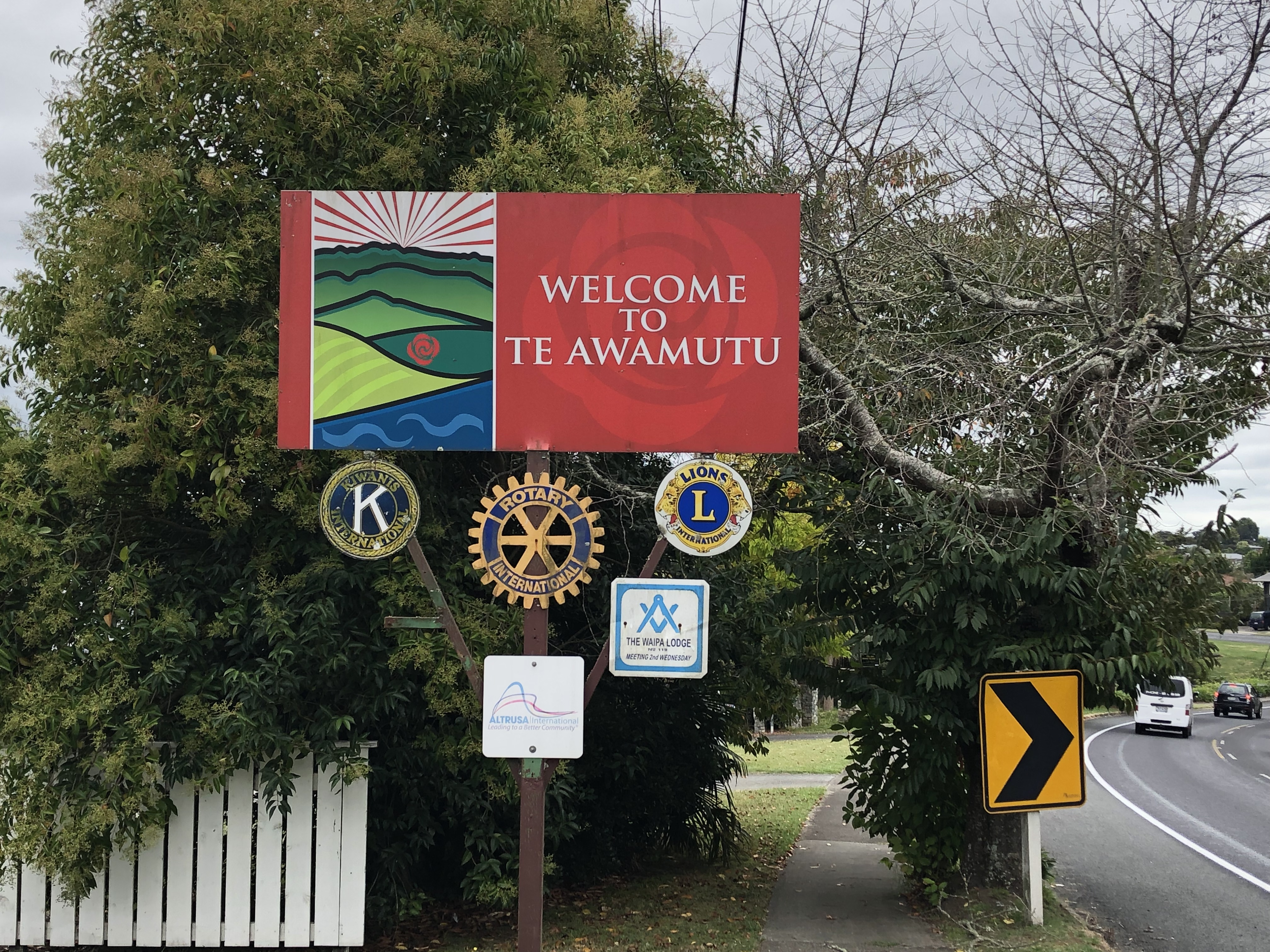
After that we moved onto a small, twisty road, hard work for the driver but a scenic drive through limestone country. Our destination for today was Waitomo, but we went on through the town, seeking out two interesting locations. The first, Marokopa Falls, was reached via a ten minute walk from the road, through temperate rainforest. The forests of the North Island have been a particular highlight of this trip. When the New Zealand Department of Conservation builds a track to a particular destination (such as here at the waterfall) it does just that. The surrounding forest is untouched, and primeval in its beauty.
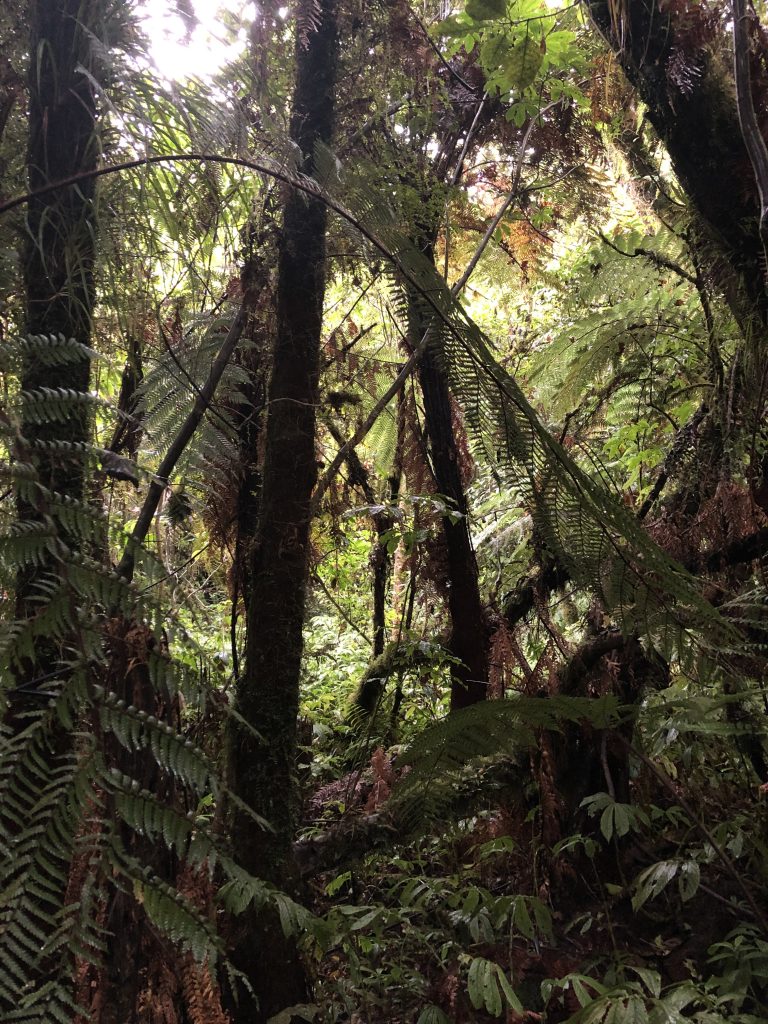

We walked in the shadow of tree ferns and tall trees, with the call of the tui and the bellbird ever present. The falls were, of course, magnificent. If you set out to design the perfect waterfall it might look something like this.
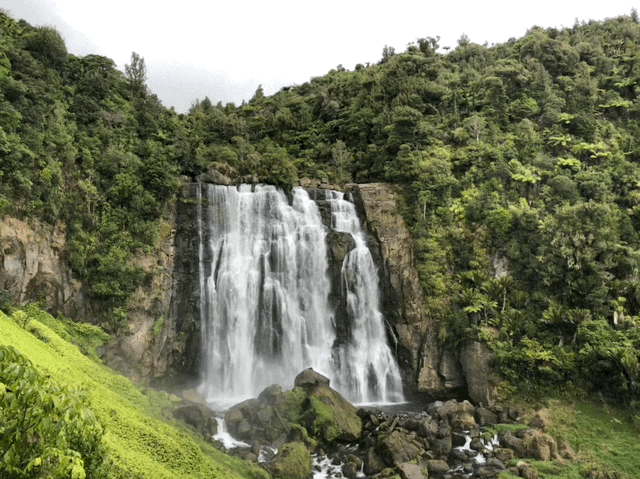
Back along the twisty road, then, to our final stop for the day, at the Mangapohue natural bridge. The walk through the forest was even shorter this time, and led to a remarkable collapsed cave system (a little like Gordale Scar at Malham). A single part of the cave roof remained, forming the “natural bridge” high above our heads. Some parts of it did look a little fragile, and we are in an earthquake zone, so we didn’t hang around for too long. Just enough time for us to take the usual number of pictures.
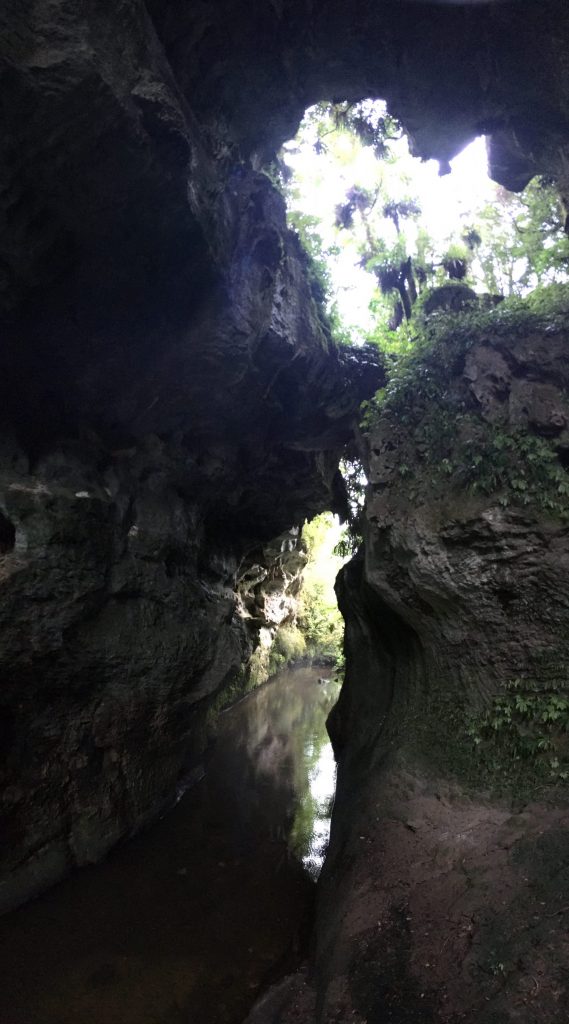
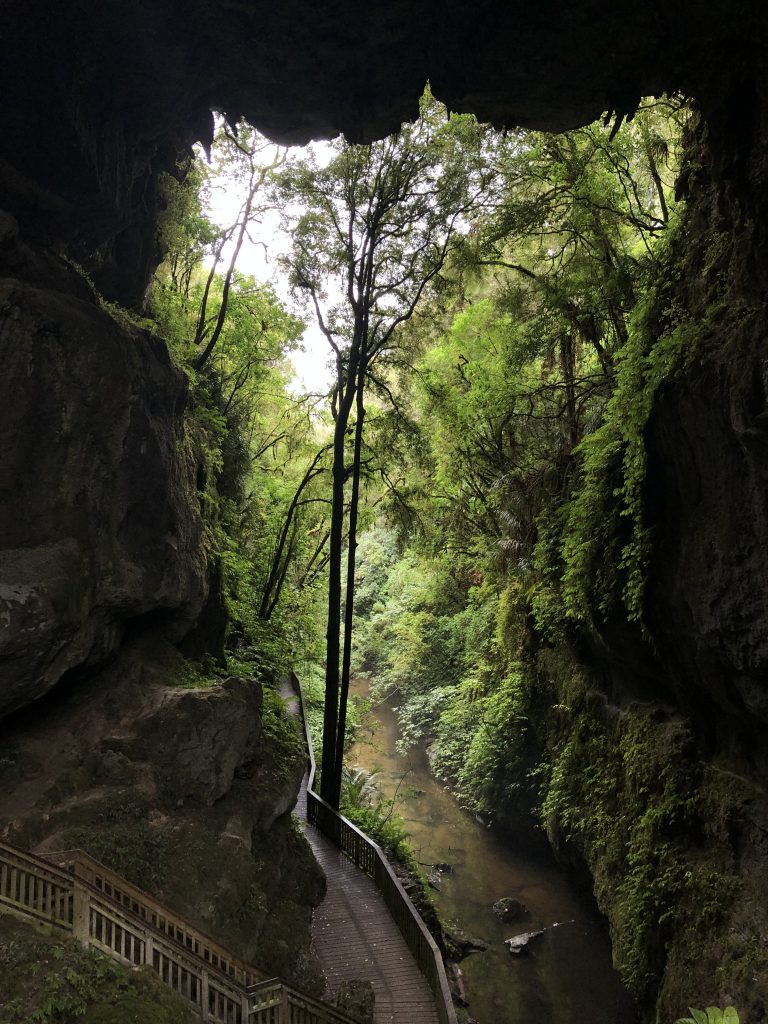
We checked in at the campsite in Waitomo, our final one of the trip, and a particularly fine location, in a sort of natural bowl. In the grounds are some “pancake rocks” similar to those we saw at Punakaiki. Up on top of the nearest large tree was a single tui, the bird which I’m sure we’ll think of most when we recall our visit to this country. I barbecued some steak and we sat at a picnic table, enjoying a particularly good Seifried Pinot Noir and reminiscing about the motorhome portion of our trip.
Motorhome day forty-five: Waitomo
It was another cloudy day, at least to start with. Of course we’re now in Autumn here, although it is still mostly very sunny. Today was limestone day. We’re in Karst country here, surrounded by the stuff, although it’s much younger here (35-40 million years old) than the Carboniferous limestone at home (325-363 million years old). It looks different too, a purer white colour. It has a softer texture, and is frequently found interleaved with softer mudstone in the “pancake rocks” style.
We’ve been down a few limestone caves in our time, but never one with glowworms before. The first cave of the day was Waitomo cave, which is owned by a Māori family. All of the staff appeared to be Māori, and our guide Stephen was a member of the family.
At first we walked through classic limestone cave formations: stalactites; stalagmites; pillars; flowstones and curtains. Occasionally when the lights were low we caught a glimpse of the glowworms above us. At the furthest extent of the cave we all climbed into a single large boat, and our guide switched all of the lights off before guiding our boat through the dark cave with the aid of guide ropes.
As our eyes grew accustomed to the light we saw a brilliant natural display. Tens of thousands of glowworms had attached themselves to the cave roof above us. It was a remarkable site – pinprick lights in green and blue, some brighter than others. Apparently the males are dimmer than the females – make of that what you will. For obvious reasons we were unable to take photographs, so here’s a picture I found online which will indicate what it was like.
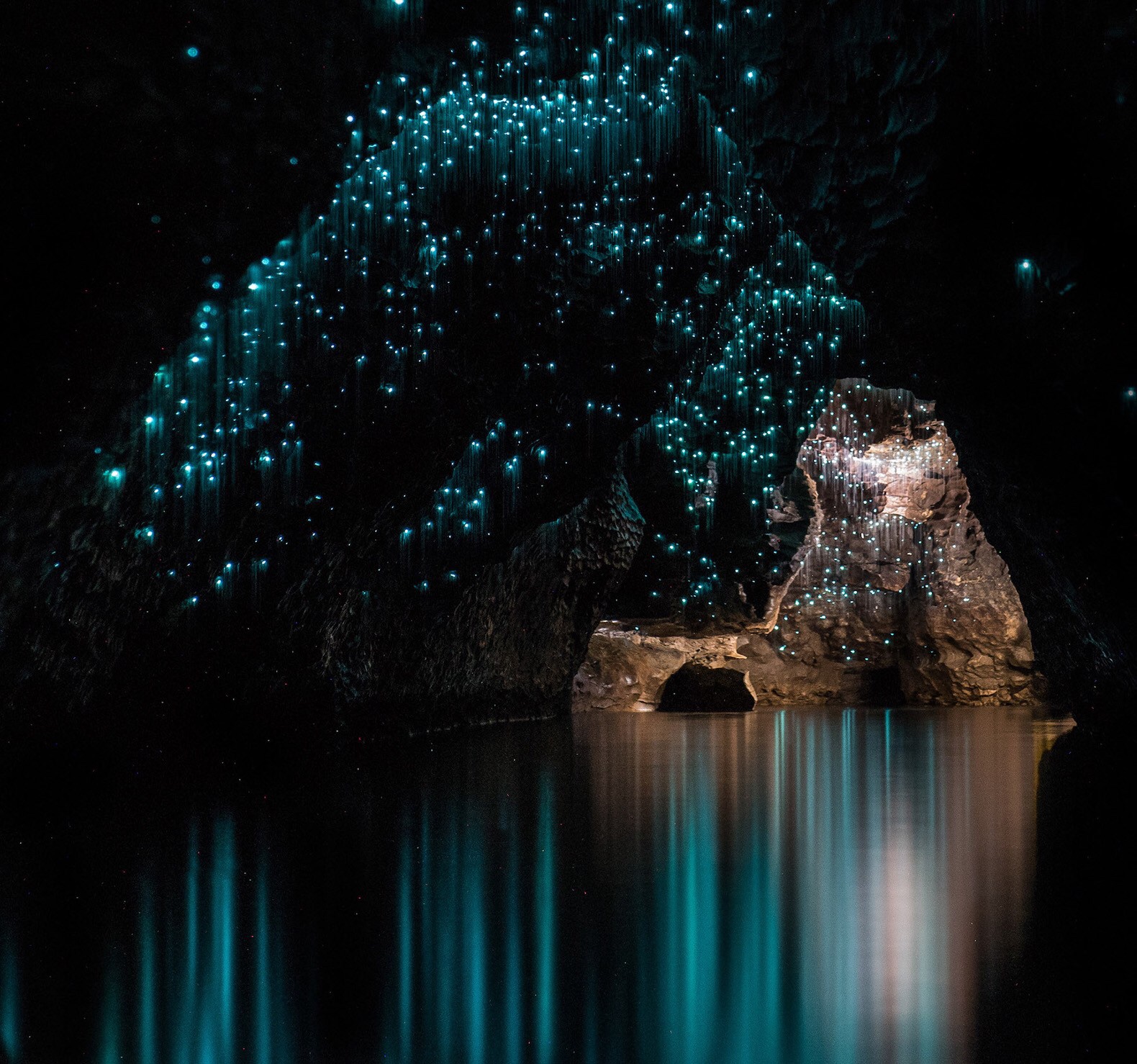
… or you can click here for a publicity video, which is worth a watch.
Eventually the boat emerged into bright daylight at the cave mouth.
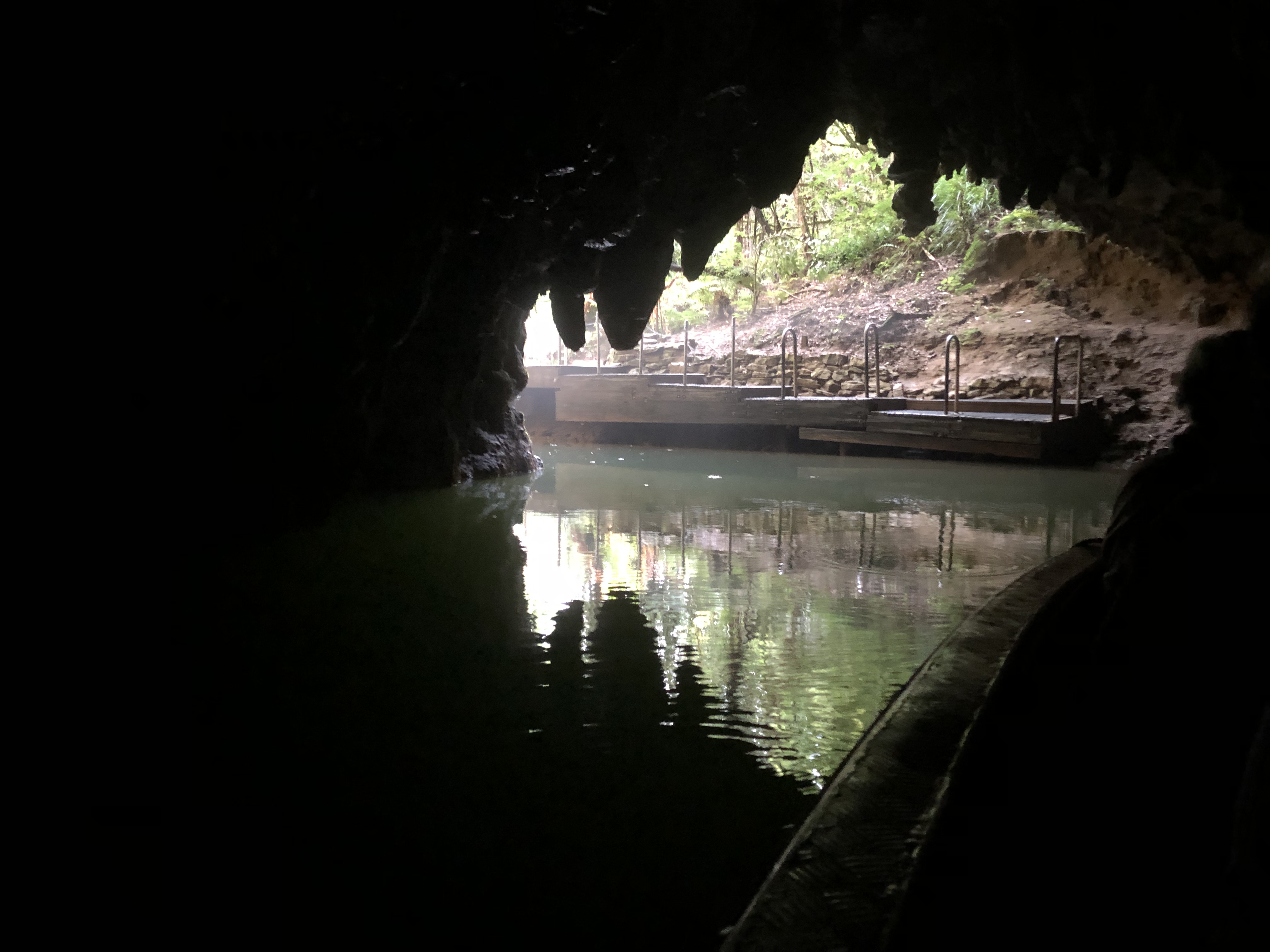
Knowing we had a short connection to make we raced off back to the motorhome and drove up to our second and final cave of the day, Ruakuri. There was no boat this time, but a two hour walking tour led by Ashley, a personable Kiwi. She marshalled our mixed group (people from Singapore, Auckland, India, Hawaii, and of course ourselves) down a spiral ramp deep into the cave entrance. The formations in this cave were as good as we’ve seen anywhere, and included “popcorn”, something we’ve never seen before, when calcite accretes in drier conditions, into a shape which really does resemble popcorn.
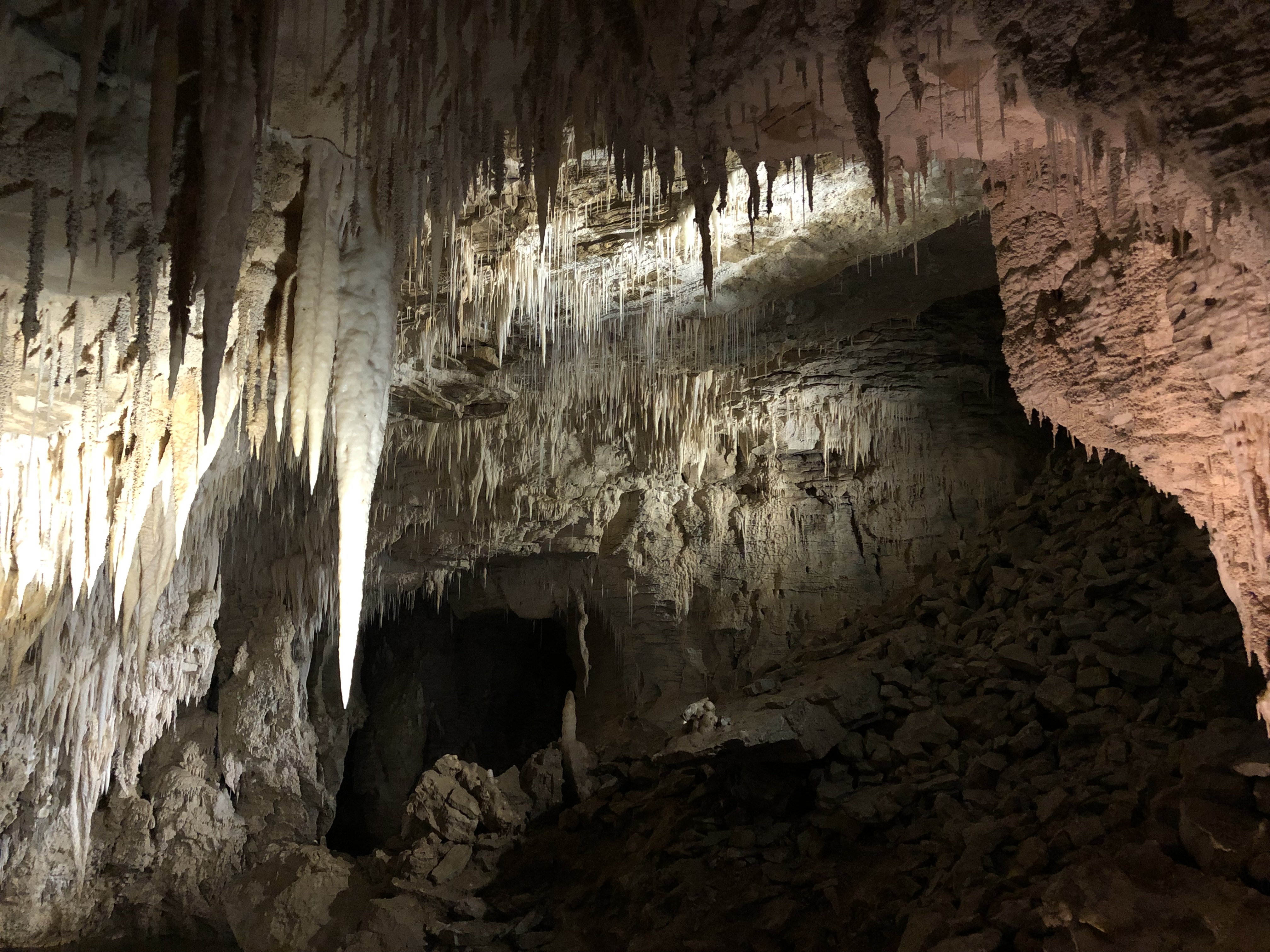
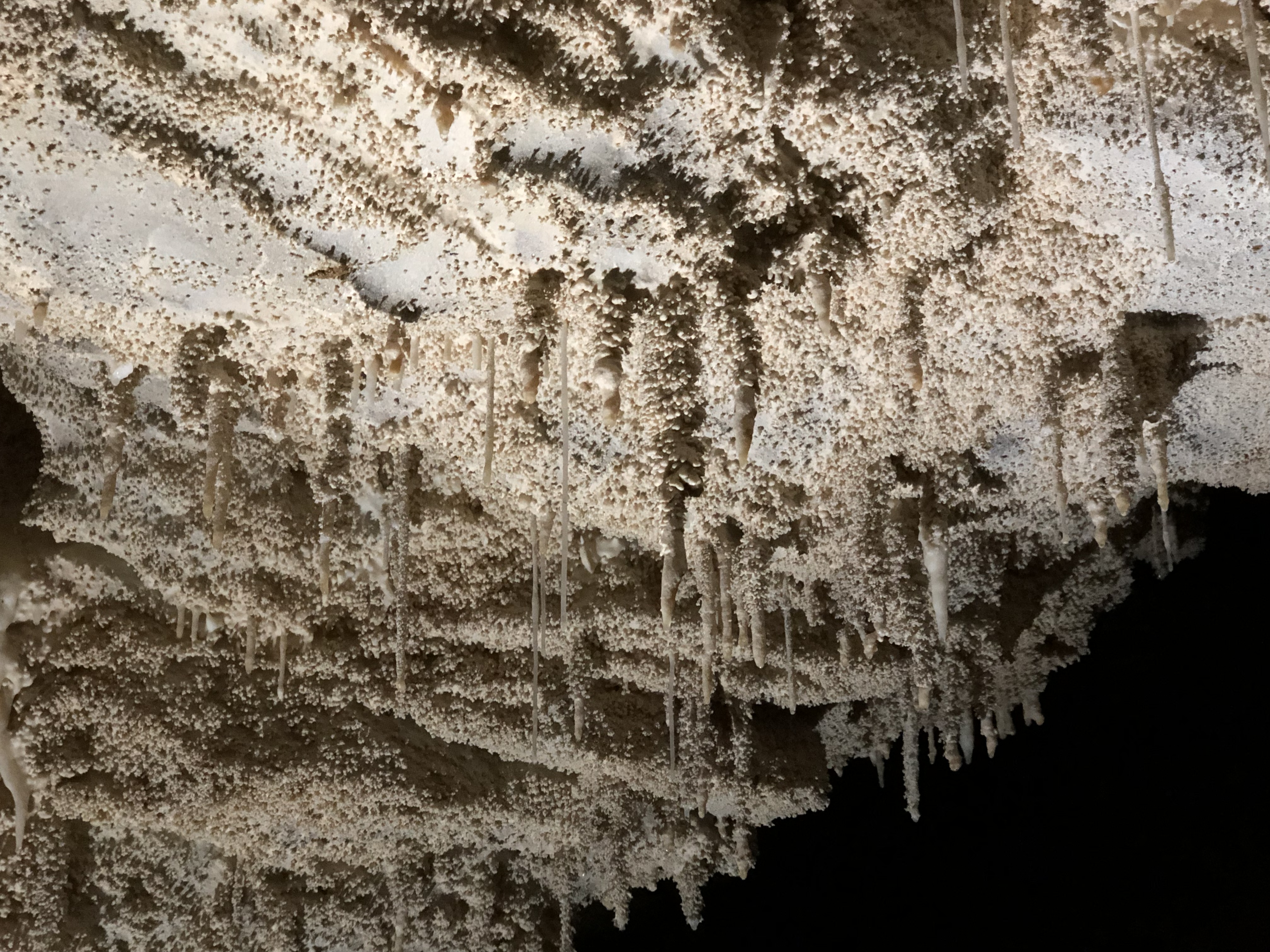
Even here inside the cave we could see the “pancake rocks” structure.
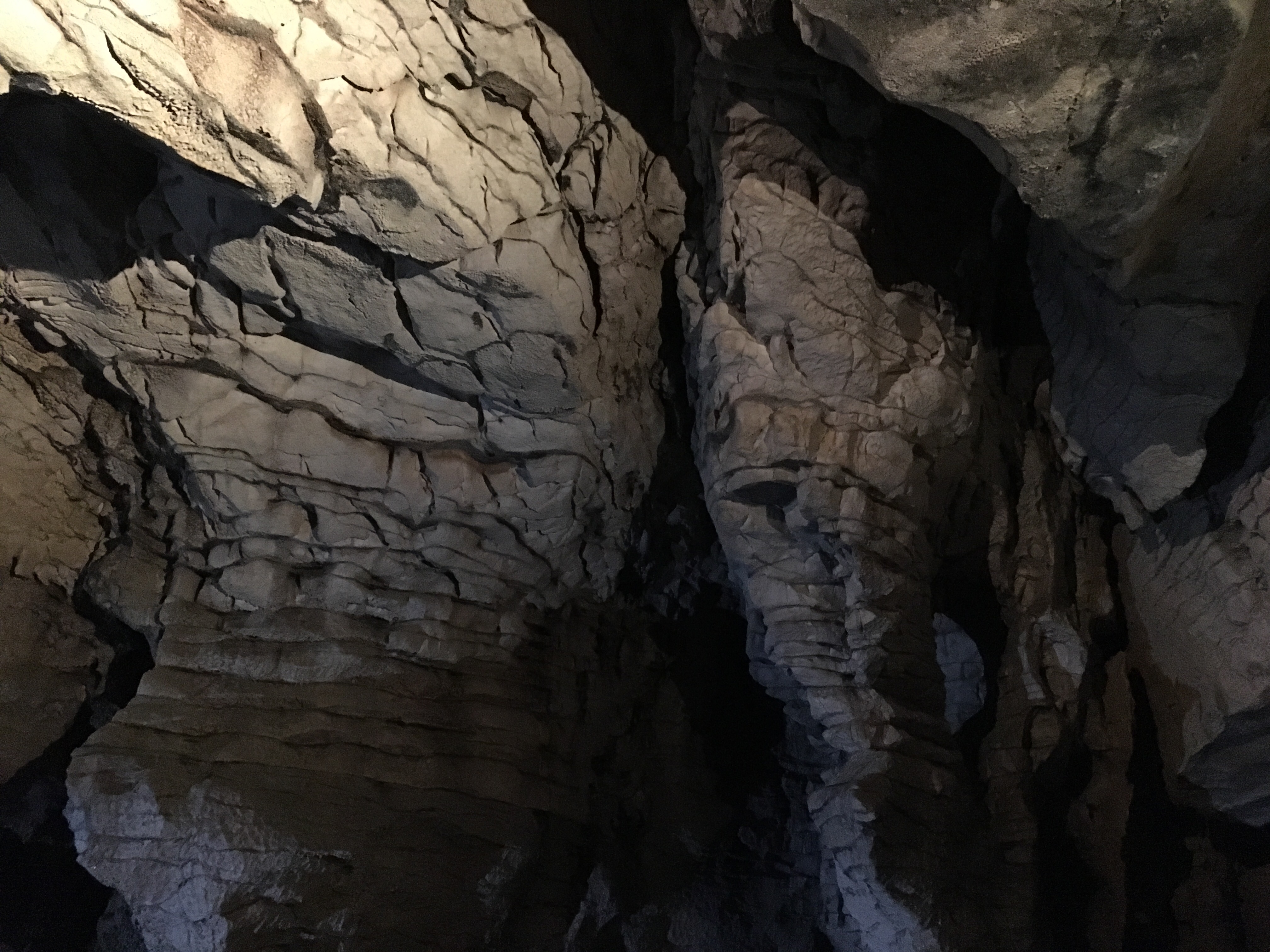
Further into the cave we got the chance for a close-up look at glowworms. They attach themselves to the roof of the cave, then lower tiny mucus-covered silk threads (up to thirty per glowworm) which are used to trap small flies, attracted by the bioluminescence. Judging by the numbers of glowworms we saw, it’s an effective strategy.
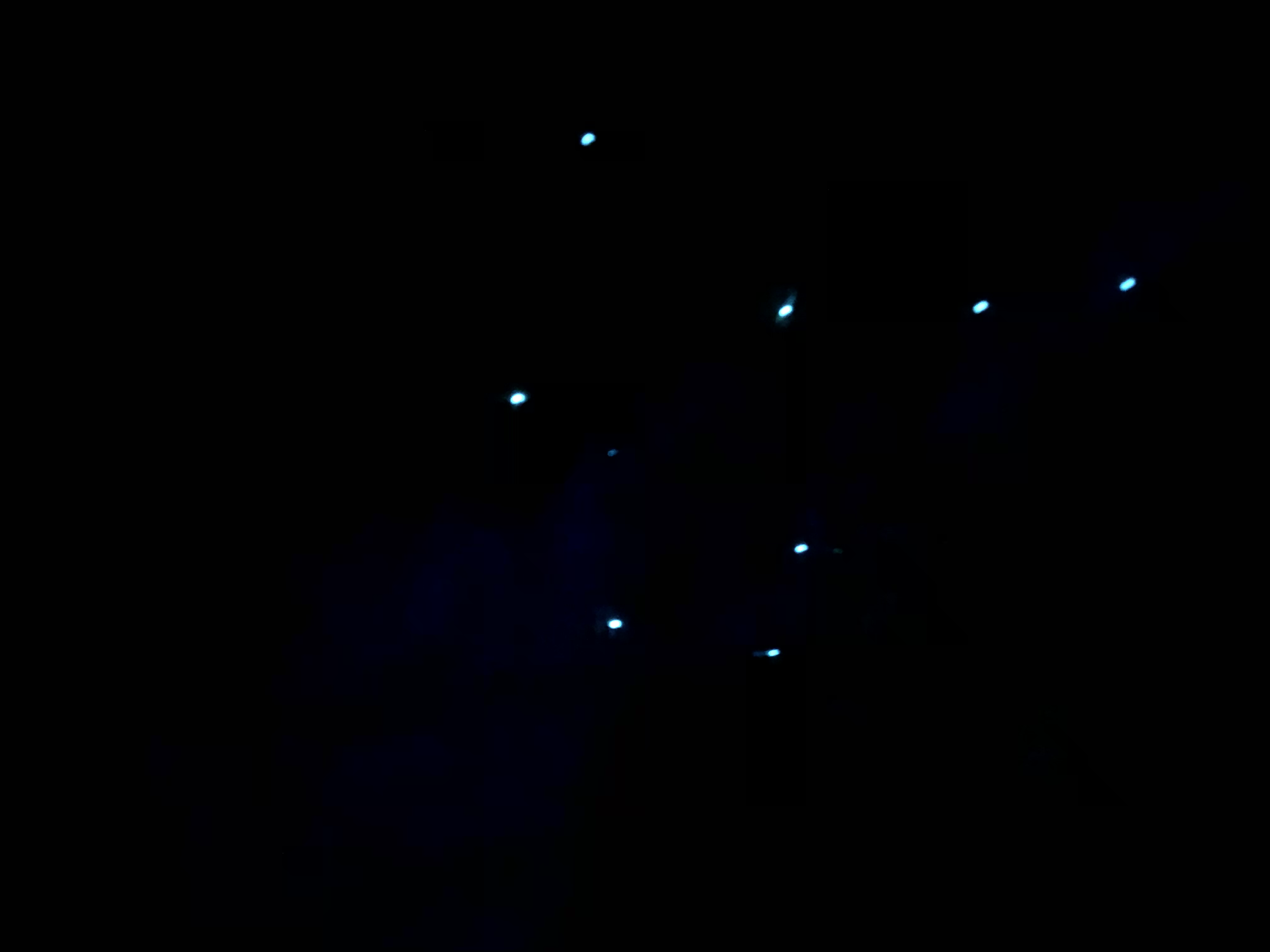
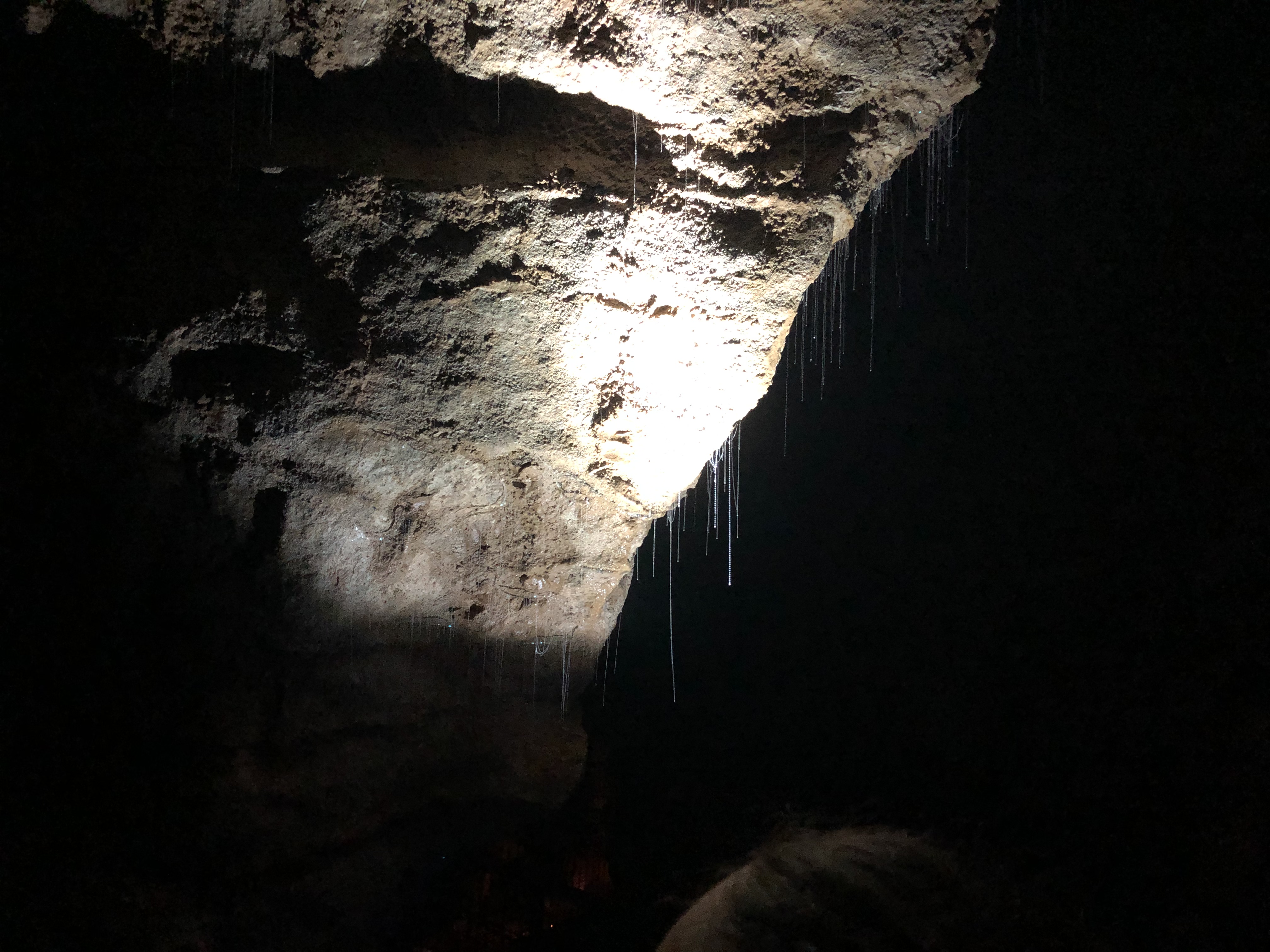
In this picture below you can see a single glowworm in the top right quadrant, with mucus-covered silk threads hanging beneath.
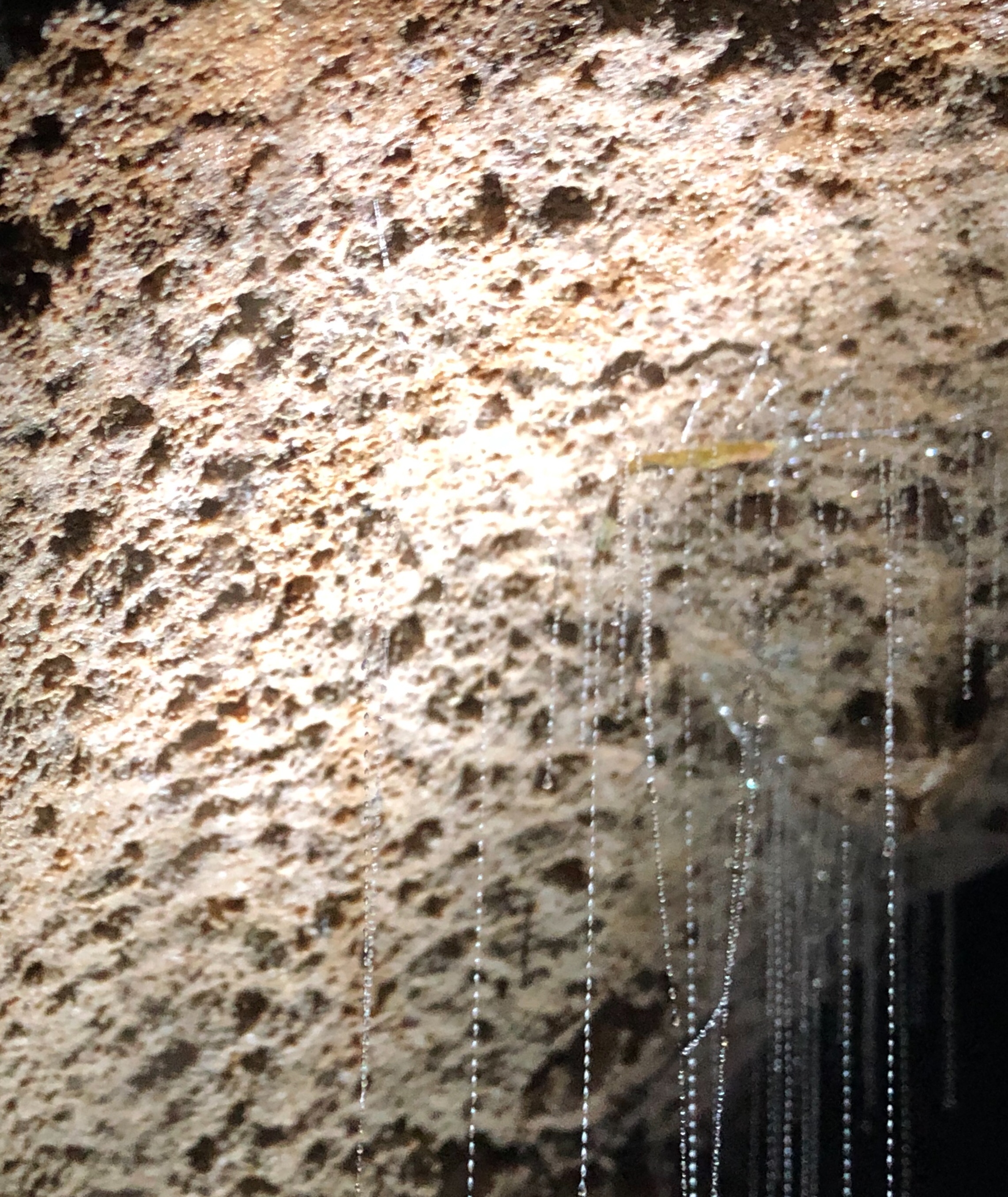
We emerged into the sunlight, blinking somewhat and enjoying the sunlight; it had been quite cool in the cave.
Back at the campsite we lunched before we started to pack up our belongings. When we checked the news we soon became aware of the horrific shootings in two Christchurch mosques today. What a tragedy, and how difficult it is to reconcile the peaceful, friendly New Zealand we have come to know with the brutal actions of a right-wing terrorist. Our thoughts, of course, are with the victims and their families.
Motorhome day forty-six: Waitomo to Auckland
As I was dozing this morning I could hear a bird outside, calling with the same short sound every few seconds. We’ve heard this particular call a few times before in the motorhome, and christened it the “Calpol” bird, because that’s what the call sounds like. Today I realised that it must be a Morepork. I read about these birds a few weeks ago – they are small brown owls, and when the original European settlers arrived they heard the call as “More Pork”!
There’s not much to report today. We woke up, had breakfast, finished our packing and cleaned the motorhome, before setting off on the two hour journey north to Auckland. After dropping off the motorhome we took an Uber into town, arriving at the lovely leafy suburb of Parnell, close to the War Memorial Museum we visited on our first spell here.
Parnell is gorgeous – it has a single main street full of trendy bars, restaurants and wine shops. The buildings are of wood, with delicate verandas on the upper floor. It must be a very nice place in which to live. We’re in a two storey town house, a short walk away from the main road. It’s nice to have some space (and a bath!) after the motorhome, and I’m writing this while sitting in the garden, listening to a very competent violinist practising next door.
Every New Zealander we’ve met today has wanted to express their mortification over yesterday’s events. It really seems to have cast a shadow over their lives, unsurprisingly. There’s a lot of anger, and there are many calls for gun control.
Tonight we plan to have a takeaway curry (yay!) and enjoy a relaxing evening outside in the garden.
Auckland redux – Waiheke Island
We had a wander around central Auckland this morning. Clare attempted to find a new bikini (unsuccessfully – all the shops are stocking their autumn lines now) and I desperately needed a haircut (this was more successful, though it’s now a tad short!). Afterwards we headed down to the quay for today’s wine tour of Waiheke Island.
Waiheke is to the east of Auckland, and getting there requires a forty minute ferry journey. The boat was packed to the gunwales, but we found a seat and enjoyed the journey. On arrival we were greeted by Davide, our Italian host for the tour. He had some funny stories to tell – more on that shortly.
We were to visit three vineyards over the course of about the same number of hours. Waiheke’s geographical position gives it an unusual microclimate, with temperatures averaging about four degrees Celsius higher than those of Auckland. It’s also considerably more humid. Unusually for New Zealand, these conditions are considered unsuitable for the growing of Pinot Noir.
Our first visit was to Mudbrick, set on a declivity looking across towards Auckland. you can just make out the skyline of Auckland (including the Skytower) in the background of this picture:
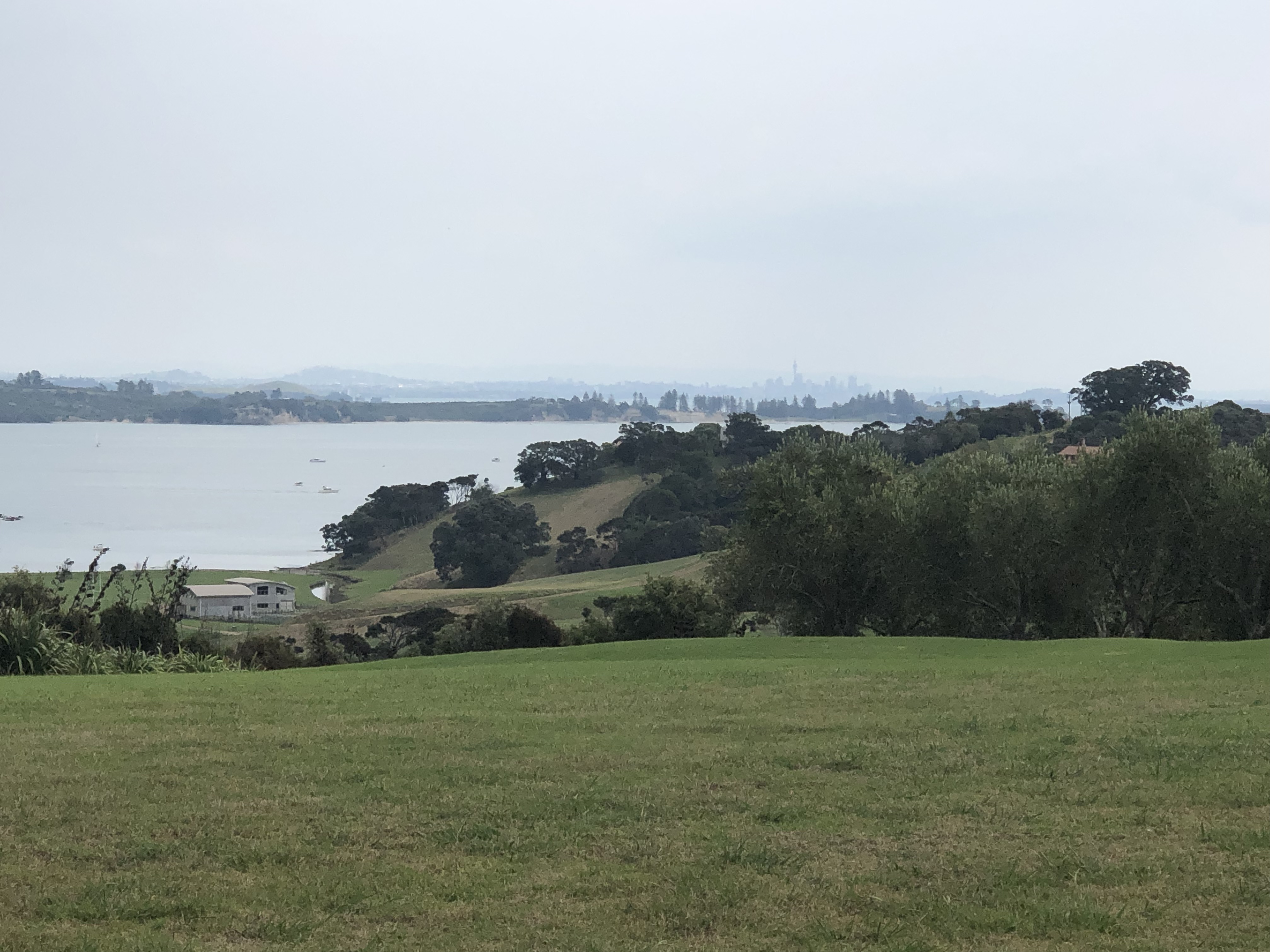
We wandered around the vineyard, glass in hand, enjoying the views. Periodically our glass would be refreshed with a different wine. How much more civilised can life be? The weight restrictions on our forthcoming flight meant we were limited to buying a single bottle from this vineyard. Mudbrick also specialises in hosting weddings (it is a stunning location), holding up to one hundred and forty ceremonies a year.
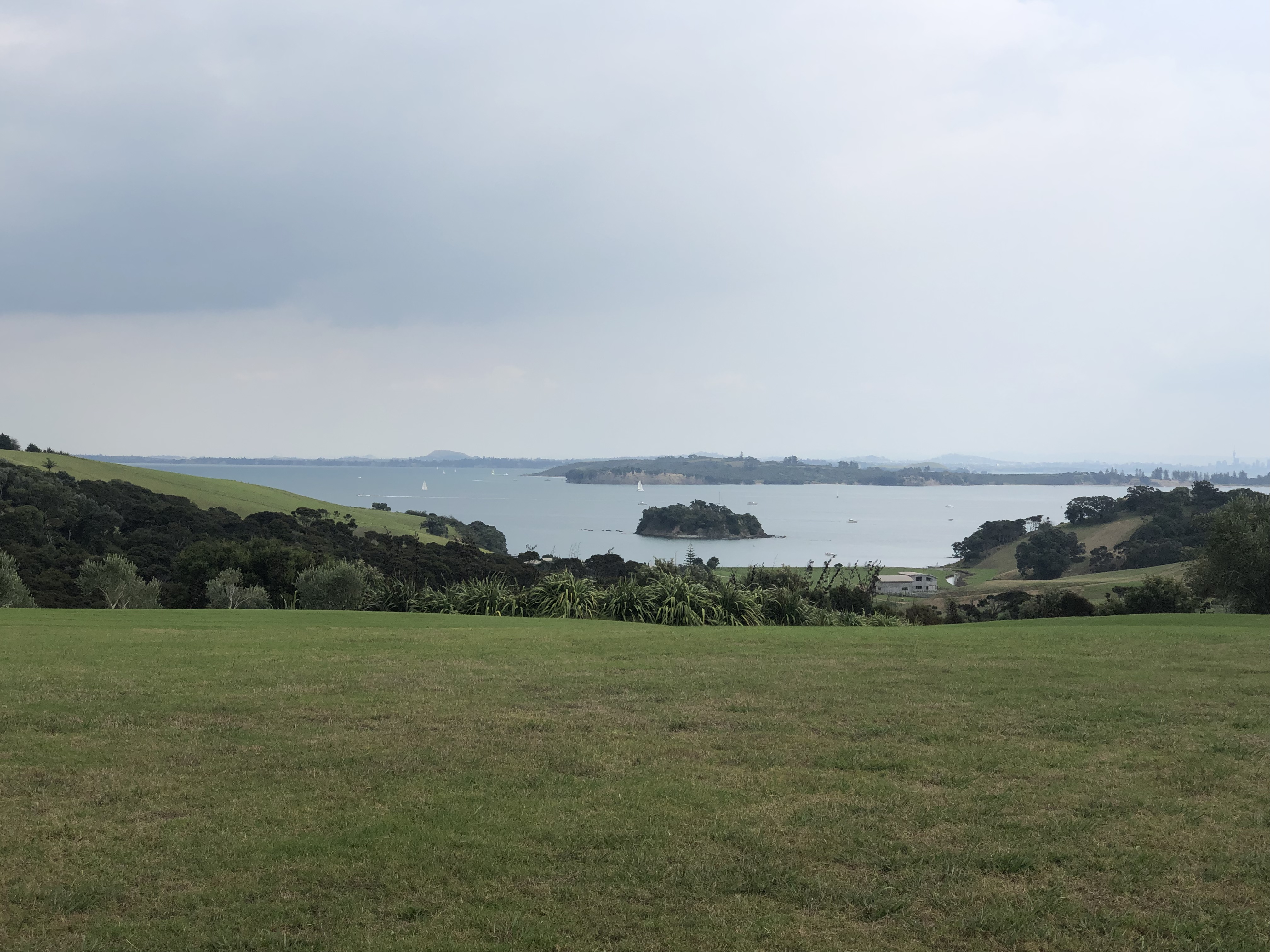
On the short bus journey between Mudbrick and Cable Bay Davide repeated a story he had just heard. Apparently it is very difficult to secure a wedding booking at Mudbrick, aspirant couples need to book well in advance. One woman was so determined to be married there that she placed a booking for a wedding eighteen months in the future. She then revealed that she had no current boyfriend…
At Cable Bay, a younger and more modern operation, we sat around a table loaded with cheeses while Tim, our host, took us through the merits of four different wines. He was interesting and knowledgeable and talked to each of us individually too, before taking us down to the cellar to see the barrels.
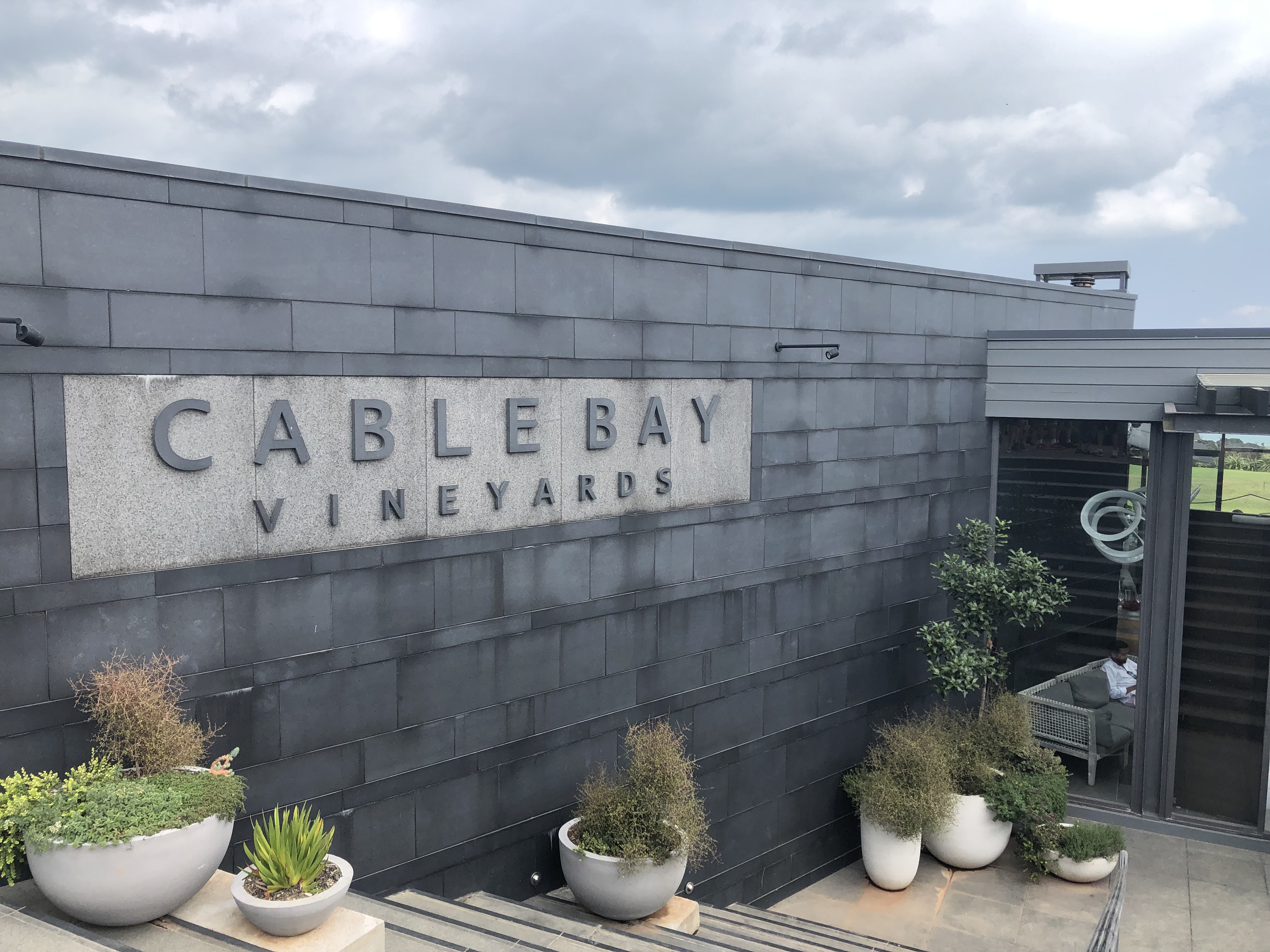
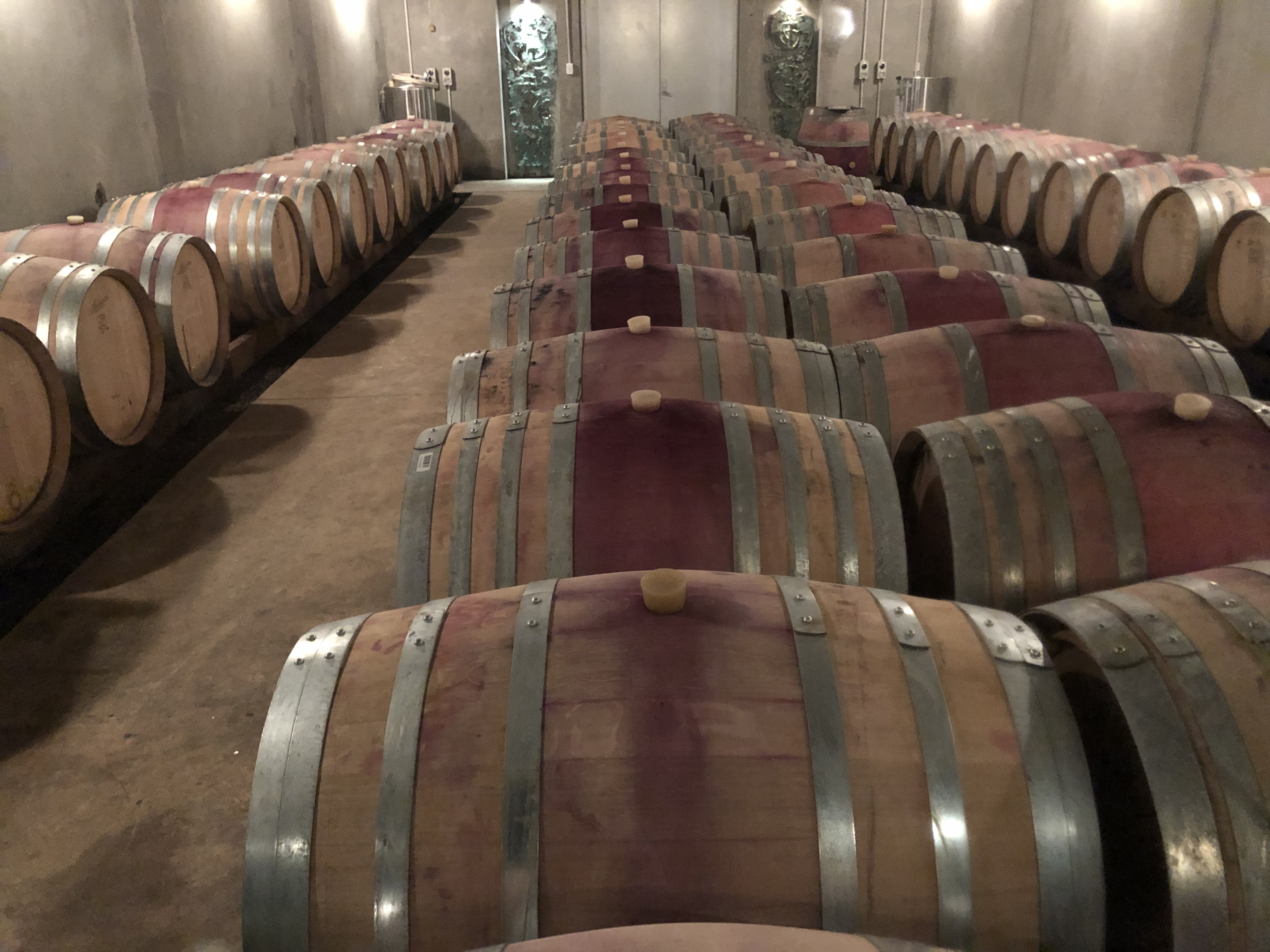
Here we acquired a couple more bottles – a Syrah and a delicious Malbec called Five Hills. The journey to our final vineyard took a little longer – around twenty minutes. This gave us the opportunity to see more of Waiheke. It’s a delightful island, with around thirty vineyards and a few towns. It has become a popular home for quite a number of people who work in Auckland, and commute each day by ferry. There’s a slight “hippy” vibe to the shops and restaurants. Oh, and it’s surrounded by extinct and dormant volcanoes.
Our final destination was Te Motu, at the end of a narrow and dusty gravel track – all credit to Davide for manoeuvring the coach down to the car park. As with the other vineyards, the white wine grapes had already been picked, and the red grapes were still awaiting harvest.
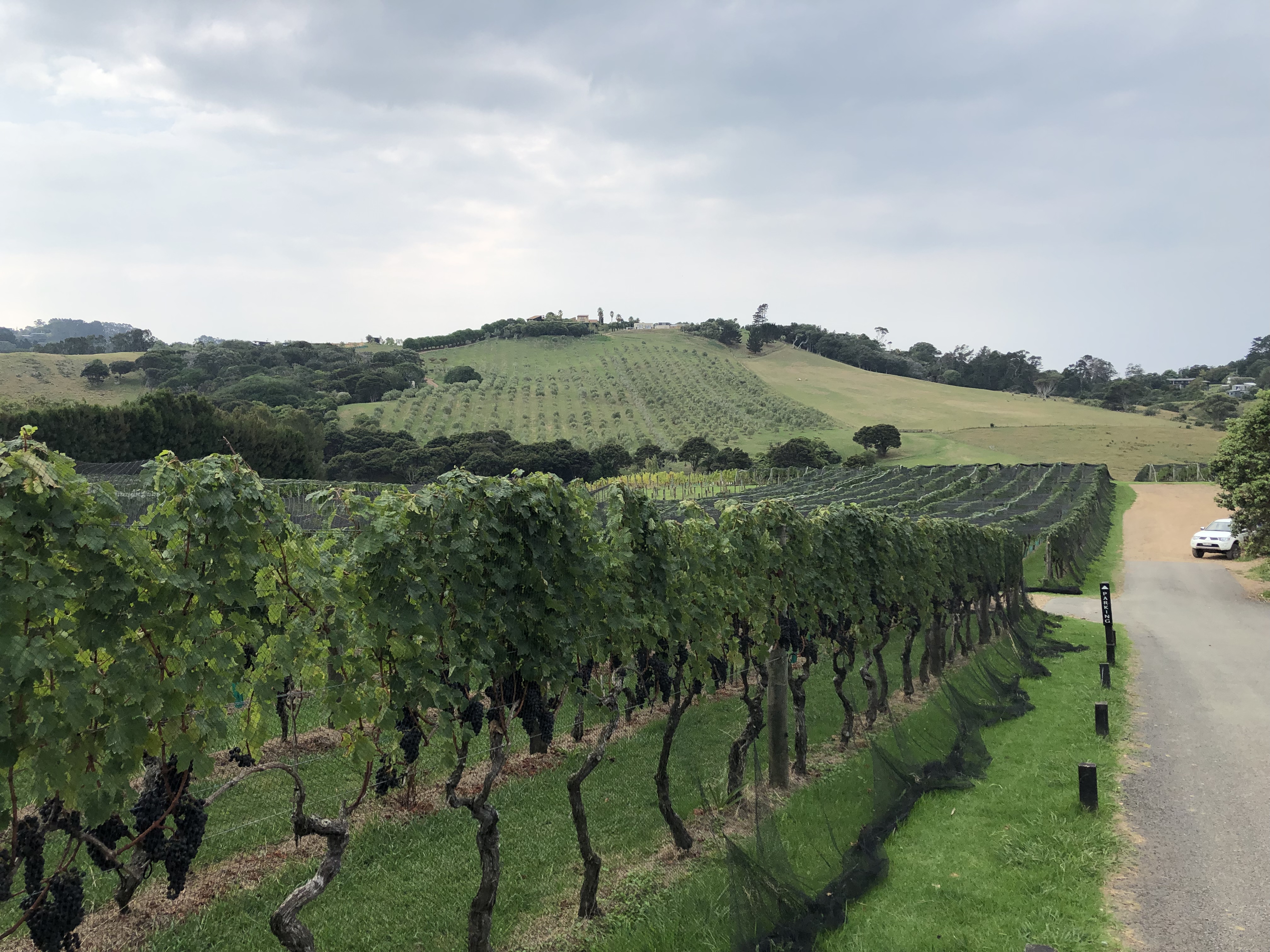
After another interesting tasting we ended up with two further bottles. By our calculations we can drink one tonight and take four with us to our next destination (where wine is considerably more pricy). Perfect!
The atmosphere on the bus was somewhat livelier than when we had set out – not sure why… It had been thoroughly enjoyable; we had certainly learned one or two new things. Davide drove us back to the ferry, where the queues were lengthy. Happily the ferry company seemed to have laid on extra ferries, and we were soon back in Parnell.
Our final day in New Zealand has arrived. We’ve been here for seven and a half weeks, and have loved every minute. The weather has been kind, the people kinder still. Above all, it is filled with sensationally beautiful destinations, each one different to the last. We think we’ve done it justice, but we’re sure to have missed a few places. We’ll bring back very fond memories and huge numbers of photographs. We’ve driven over five and a half thousand kilometres (almost three and a half thousand miles).
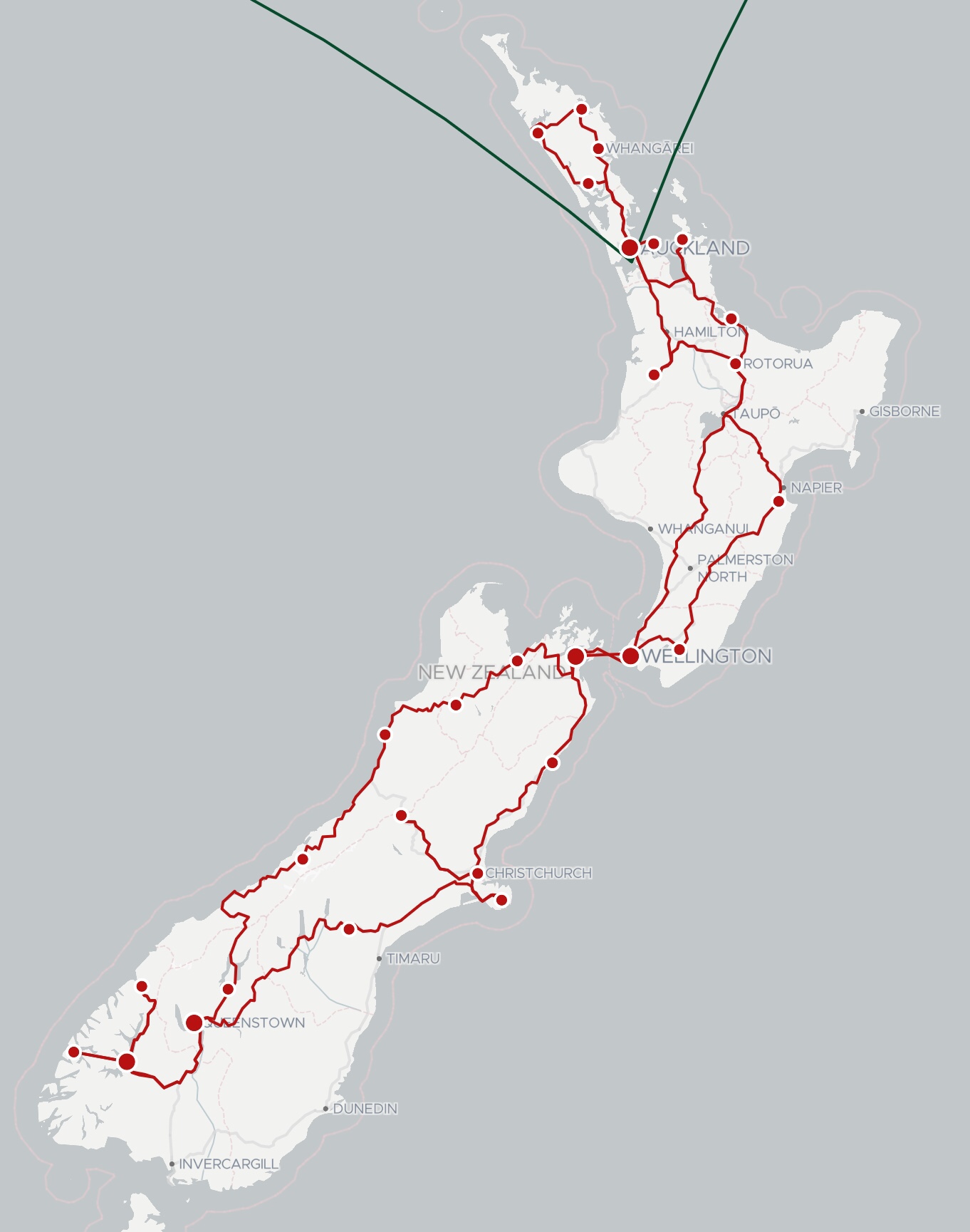
It’s time to move on, though, and the prospect of a long lazy week in Tahiti and Bora Bora beckons!
